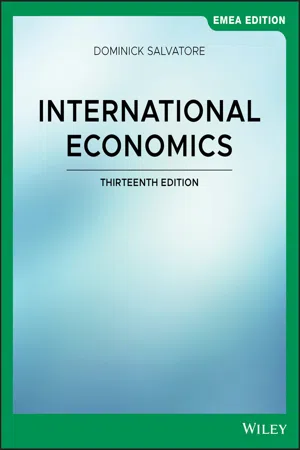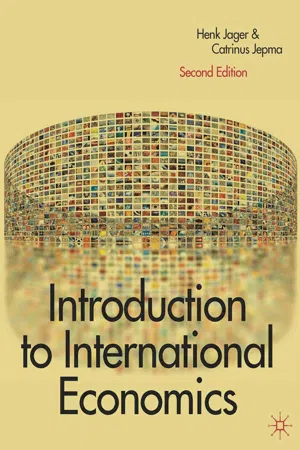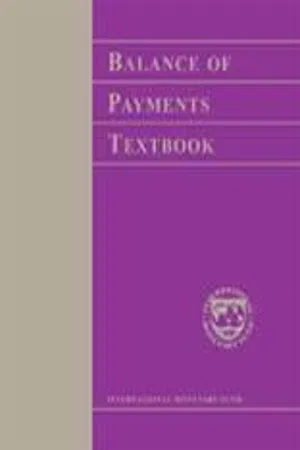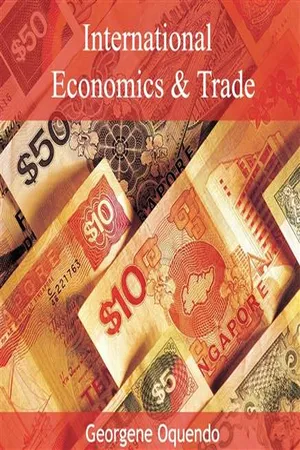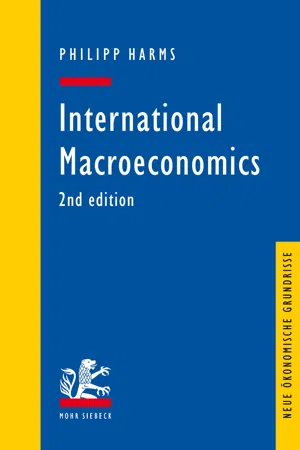Economics
Balance of Payments
The balance of payments is a record of all economic transactions between a country and the rest of the world over a specific period. It consists of the current account, which includes trade in goods and services, and the capital account, which tracks financial transactions. A surplus or deficit in the balance of payments can indicate a country's economic strength or vulnerability.
Written by Perlego with AI-assistance
Related key terms
1 of 5
11 Key excerpts on "Balance of Payments"
- eBook - PDF
- Dominick Salvatore(Author)
- 2020(Publication Date)
- Wiley(Publisher)
We now begin our examination of the monetary aspects of international economics, or international finance. Here, money is explicitly brought into the picture, and commodity prices are expressed in terms of domestic and foreign currency units. We begin our discussion of international finance by examining the Balance of Payments. The Balance of Payments is a summary statement in which, in principle, all the trans-actions of the residents of a nation with the residents of all other nations are recorded dur-ing a particular period of time, usually a calendar year. The United States and some other nations also keep such a record on a quarterly basis. The main purpose of the Balance of Payments is to inform the government of the international position of the nation and to help it in its formulation of monetary, fiscal, and trade policies. Governments also regularly consult the Balance of Payments of important trade partners in making policy decisions. The information contained in a nation’s Balance of Payments is also indispensable to banks, firms, and individuals directly or indirectly involved in international trade and finance. The definition of the Balance of Payments just given requires some clarification. First of all, it is obvious that the literally millions of transactions of the residents of a nation with the rest of the world cannot appear individually in the balance payments. As a sum-mary statement , the Balance of Payments aggregates all merchandise trade into a few major categories. Similarly, only the net balance of each type of international financial flow is included. Furthermore, the Balance of Payments includes some transactions in which the residents of foreign nations are not directly involved—for example, when a nation’s central bank sells a portion of its foreign currency holdings to the nation’s commercial banks. - eBook - PDF
- Dominick Salvatore(Author)
- 2019(Publication Date)
- Wiley(Publisher)
We now begin our examination of the monetary aspects of international economics, or international finance. Here, money is explicitly brought into the picture, and commodity prices are expressed in terms of domestic and foreign currency units. We begin our discussion of international finance by examining the Balance of Payments. The Balance of Payments is a summary statement in which, in principle, all the trans- actions of the residents of a nation with the residents of all other nations are recorded dur- ing a particular period of time, usually a calendar year. The United States and some other nations also keep such a record on a quarterly basis. The main purpose of the Balance of Payments is to inform the government of the international position of the nation and to help it in its formulation of monetary, fiscal, and trade policies. Governments also regularly consult the Balance of Payments of important trade partners in making policy decisions. The information contained in a nation’s Balance of Payments is also indispensable to banks, firms, and individuals directly or indirectly involved in international trade and finance. The definition of the Balance of Payments just given requires some clarification. First of all, it is obvious that the literally millions of transactions of the residents of a nation with the rest of the world cannot appear individually in the balance payments. As a sum- mary statement, the Balance of Payments aggregates all merchandise trade into a few major categories. Similarly, only the net balance of each type of international financial flow is included. Furthermore, the Balance of Payments includes some transactions in which the residents of foreign nations are not directly involved—for example, when a nation’s central bank sells a portion of its foreign currency holdings to the nation’s commercial banks. - eBook - PDF
- William Boyes, Michael Melvin(Authors)
- 2015(Publication Date)
- Cengage Learning EMEA(Publisher)
In such times, it seems as if everywhere there is talk of the Balance of Payments. The Balance of Payments is a record of a country’s trade in goods, services, and finan-cial assets with the rest of the world. This record is divided into categories, or accounts, that summarize the nation’s international economic transactions. For example, one category measures transactions in merchandise; another measures transactions involving financial assets (bank deposits, bonds, stocks, loans). Balance of Payments data are reported quarterly for most developed countries. Once we understand the various definitions of the Balance of Payments, there remains the issue of why we should care. One important reason is that balance of pay-ments issues are often hot political topics. One cannot make sense of the political debate without an understanding of Balance of Payments basics. For instance, the United States is said to have a large deficit in its merchandise trade with the rest of the world. Is this bad? Some politicians will argue that a large trade deficit calls for government action, as it is harmful for a nation to buy more than it sells to the rest of the world. The econom-ics of the Balance of Payments allows us to judge the value of such arguments. Some policymakers, labor leaders, and business people will argue that it is bad if a country has a trade deficit with another single country. For instance, if the United States has a trade deficit with Japan, it is common to hear calls for policy aimed at eliminating this bilat-eral trade deficit. Once again, an understanding of the economics of the trade deficit allows a proper evaluation of calls for policies aimed at eliminating bilateral trade imbal-ances. We will encounter references to policy issues related to the Balance of Payments in later chapters. 6-2a Accounting for International Transactions The Balance of Payments is an accounting statement known as a balance sheet. - eBook - PDF
- Henk Jager, Catrinus Jepma(Authors)
- 2017(Publication Date)
- Red Globe Press(Publisher)
CHAPTER 11 The Balance of Payments and the Foreign-Exchange Market 11.1 Introduction A country’s Balance of Payments is a summary of the economic transactions between that country and the rest of the world over a particular period of time – usually a month, a quarter, or a year. These transactions are classified into homogeneous groups. The main classification of the Balance of Payments is into two accounts: (i) the current account , which records the transactions associated with the international trade in goods and services, and (ii) the financial account , which shows all international capital transactions. The main sub-division of the financial account is that between long-term and short-term capital flows, which reflects the underlying idea that long-term flows are much more stable over time than short-term flows. One of the most notorious of all short-term flows is speculative capital, so-called ‘hot’ money, the enormous funds that can flow in and out of economies almost instanta-neously. The growth in these flows is believed to have had a destabilizing effect on national economies and has been the subject of much criticism during the currency crises since 1990. Although the Balance of Payments is drawn up for a single country, it is of course possible – and may be useful – to consolidate balances of payments for a group of countries. One important recent example is the combined Balance of Payments for the Euro area – those European countries that have adopted a common currency, the euro. For the purpose of statistical processing it is necessary to have a detailed knowledge of how transactions are recorded on the Balance of Payments. Of course, this knowledge is also required, if in less detail, for a proper analysis of a country’s Balance of Payments or an international comparison of balance-of-payments positions. - eBook - ePub
- International Monetary Fund(Author)
- 1996(Publication Date)
- INTERNATIONAL MONETARY FUND(Publisher)
I. The Balance of Payments Conceptual Framework
1 . Balance of Payments statistics are included in a broad set of economic statistics known as the national accounts . The System of National Accounts 1993 (1993 SNA) presents the conceptual framework for the national accounts, and the fifth edition (1993) of the Balance of Payments Manual (the BPM ) presents the conceptual framework and the structure and classification of the Balance of Payments. The high level of concordance between the 1993 SNA and the BPM is extremely important.1 This first chapter of the Balance of Payments Textbook (the Textbook ) presents the Balance of Payments conceptual framework and certain internationally agreed-upon accounting conventions that have influenced the shape of that framework. These concepts and specific aspects of methodology are elaborated in subsequent Textbook chapters.Passage contains an image
Definition of the Balance of Payments
2 . As defined in the BPM , the Balance of Payments (BOP) isa statistical statement that systematically summarizes, for a specific time period, the economic transactions of an economy with the rest of the world. Transactions, for the most part between residents and nonresidents, consist of those involving goods, services, and income; those involving financial claims on, and liabilities to, the rest of the world; and those (such as gifts) classified as transfers, which involve offsetting entries to balance—in an accounting sense—one-sided transactions. Each component of this important definition is subsequently examined.3 . The Balance of Payments is concerned with transactions and thus deals with flows rather than with stocks. That is, the Balance of Payments deals with economic events that take place during a reference period and not with outstanding totals of economic assets and liabilities that exist at particular moments in time.4 . The initial focus of the Textbook is on transactions (between an economy and the rest of the world) in goods, services, and income. Under what circumstances does an international economic occurrence constitute a transaction in the BOP sense of the word? In the framework of the national accounts, transactions in goods, services, or income are the provision, by one party to another, of real resources of this kind. Thus defined, a transaction involves two parties or transactors. It is not always clear, however, that there are two parties. Real resources are often transferred internationally from one constituent unit to another within the same legal entity. (For example, real resources may be transferred between a branch and the head office of a multinational enterprise.) It is equally difficult to determine whether transactions take place when individuals migrate and transfer assets from their former to their new countries. How should real resources that accompany migrating individuals be regarded? Such movements of resources do not involve two parties although, in the process, the wealth of some economies is diminished (countries of emigration) and the wealth of other economies is increased (countries of immigration). When individuals migrate, the economic impact of the shifts in real resources is similar to that of flows of resources between two parties. It is therefore possible to regard these shifts as transactions in a restricted sense. The determination of what constitutes a transaction must not be made strictly on the basis of logic but through adoption of generally agreed-upon conventions. For the sake of convenience, the term transaction is often used broadly in the BPM - eBook - PDF
- John E. Marthinsen(Author)
- 2020(Publication Date)
- De Gruyter(Publisher)
Chapter 17 Balance of Payments One of the most openly visible but misunderstood economic reports is the bal-ance of payments (BOP), which provides a wealth of useful information about a nation ’ s economic relations with the rest of the world. This chapter explains how to read and interpret Balance of Payments statistics and reports. Because countries and international agencies can use whatever methods they wish for their Balance of Payments reports, this chapter focuses on the collection techni-ques and reporting methods of the International Monetary Fund (IMF). Using the IMF ’ s Balance of Payments reports allows us to compare statistics of the IMF ’ s 189 member countries. 1 The Basics What Is the Balance of Payments? The Balance of Payments is a summary of all transactions between the residents of one nation and the residents of the rest of the world during a given period. Notice that the Balance of Payments measures flows, which means it records changes in international assets and liabilities, rather than amounts, as well as international revenues and expenses. The Balance of Payments includes virtually any legitimate international transaction you can imagine, such as: (1) exports and imports of goods and services, (2) receipts and payments of investment income (e.g., dividends and interest), (3) gifts and aid given and received, (4) purchases and sales of natural resources, (5) debt forgiveness, (6) borrowing and lending, (7) purchases and sales of financial investments, such as stocks and bonds, (8) investments in plant and equipment, and (9) central bank intervention in foreign exchange markets. 1 The IMF publishes a monthly report (since 1948), called International Financial Statistics , which contains Balance of Payments figures and other vital macroeconomic information on its 189 member countries. The IMF database has approximately 32,000 time series and accounts for the vast majority of world trade. - eBook - PDF
- Dominick Salvatore(Author)
- 2012(Publication Date)
- Wiley(Publisher)
In Section 10.3 we present some Balance of Payments accounting principles. Section 10.4 explains the meaning of double-entry bookkeeping that is used in measuring the Balance of Payments. Section 10.5 presents and analyzes the international transactions of the United States for the year 2009. Section 10.6 examines accounting Chapter Ten Balance of Payments 259 balances and disequilibrium in the international transactions of the United States. Section 10.7 then examines the concept and measurement of a balance- of-payments deficit or surplus. Section 10.8 briefly reviews the postwar balance-of-payments history of the United States. Finally, Section 10.9 examines the international investment position of the United States. 10.2 THE Balance of Payments: DEFINITION AND USE The Balance of Payments is a summary statement in which, in principle, all Balance of pay- ments A summary statement of all the transactions of the residents of a nation with the rest of the world during a par- ticular period of time, usually a year. the transactions of the residents of a nation with the residents of all other nations are recorded during a particular period of time, usually a calendar year. The United States and some other nations also keep such a record on a quarterly basis. The main purpose of the Balance of Payments is to inform the government of the international position of the nation and to help it in its formulation of monetary, fiscal, and trade policies. Governments also regularly consult the Balance of Payments of important trade partners in making policy decisions. The information contained in a nation’s Balance of Payments is also indispensable to banks, firms, and individuals directly or indirectly involved in international trade and finance. The definition of the Balance of Payments just given requires some clarification. - eBook - PDF
Trading Economics
A Guide to Economic Statistics for Practitioners and Students
- Trevor Williams, Victoria Turton(Authors)
- 2014(Publication Date)
- Wiley(Publisher)
And that is not always clear-cut. For example, one of the positives of having a cheap currency is that it can encourage investors to switch production to your economy, as exports from your country are cheaper than those from other countries they could locate in. THE CONCEPT OF THE Balance of Payments The UK’s Balance of Payments measures its transactions with the rest of the world. It is one of the most important of the data releases each month and has been known to bring down governments, or at least it has been accused of helping them to lose elections. The Balance of Payments helps to determine the value of the currency and therefore helps to determine domestic prices of goods and services. It directly impacts living standards, employment and the ability of the country to pay its way in the world and for its people to maintain their standard of living. By measuring economic transactions between the UK and the rest of the world, the Balance of Payments shows how the net flow of the 200 Trading Economics balance of goods and services between inward and outward activities is funded. It encompasses: ∙ Exports and imports of visible goods, such as cars, food, medicines, capital goods and machinery. ∙ Exports and imports of services such as travel, financial, legal and education. ∙ Net flows of income between the UK and the rest of the world, such as interest earned on investment here and abroad, equity returns, dividends and so on. ∙ Flows such as investment in companies and plant and machinery in the UK and outside by UK firms. ∙ Transfers such as those that take place when migrants in the UK send funds overseas and UK migrants abroad send money back to people in the UK. These are all netted out to show the balance position. What does this mean exactly? Table 7.1 gives an example that follows this trail. In theory, any business transaction must have two sides to it – one thing is exchanged for another of equal value. - eBook - PDF
- Rhona C. Free(Author)
- 2010(Publication Date)
- SAGE Publications, Inc(Publisher)
41 BALANCE OF TRADE AND PAYMENTS LAWRENCE D. GWINN Wittenberg University T he Balance of Payments registers the international financial position of a country, using a double-entry bookkeeping approach to tabulate the market value of the transactions in goods, services, and financial assets between the country's residents and the residents of the rest of the world. Like gross domestic product (GDP), the Balance of Payments encompasses transactions in goods and services produced during the year, but, unlike the GDP, the balance also encompasses transactions in assets. In addition to categorizing international transac-tions as debits or credits, the Balance of Payments sepa-rates private transactions in goods and services into the current account and transactions in assets into the capital account. Official government transactions, undertaken to affect the exchange rate, are typically separated from private transactions in Balance of Payments accounting. While nations had been aware of the relationship between their exports and imports since they first coa-lesced into discernable entities and began to trade, in History of Economic Analysis (1954), Joseph Schumpeter likens the conceptualization of the Balance of Payments to an idea that has been vaguely known for centuries without being fully understood. Schumpeter credits Antonio Serra with having the first clear conception of the Balance of Payments in 1613. While Serra recognized and understood many of the mercantilist ideas, according to Schumpeter, his most important point was an understanding of the connection between a country's Balance of Payments posi-tion and its domestic economic situation. Schumpeter also mentions Thomas Mun (1571-1641) and other mercan-tilists as having an understanding of the balance of pay-ments, notwithstanding their misapplication of its principles to trade policy. - No longer available |Learn more
- (Author)
- 2014(Publication Date)
- Orange Apple(Publisher)
____________________ WORLD TECHNOLOGIES ____________________ Chapter- 7 Balance of Payments A Balance of Payments (BOP) sheet is an accounting record of all monetary transactions between a country and the rest of the world. These transactions include payments for the country's exports and imports of goods, services, and financial capital, as well as financial transfers. The BOP summarises international transactions for a specific period, usually a year, and is prepared in a single currency, typically the domestic currency for the country concerned. Sources of funds for a nation, such as exports or the receipts of loans and investments, are recorded as positive or surplus items. Uses of funds, such as for imports or to invest in foreign countries, are recorded as a negative or deficit item. When all components of the BOP sheet are included it must balance – that is, it must sum to zero – there can be no overall surplus or deficit. For example, if a country is importing more than it exports, its trade balance will be in deficit, but the shortfall will have to be counter balanced in other ways – such as by funds earned from its foreign investments, by running down reserves or by receiving loans from other countries. While the overall BOP sheet will always balance when all types of payments are included, imbalances are possible on individual elements of the BOP, such as the current account. This can result in surplus countries accumulating hoards of wealth, while deficit nations become increasingly indebted. Historically there have been different approaches to the question of how to correct imbalances and debate on whether they are something governments should be concerned about. With record imbalances held up as one of the contributing factors to the financial crisis of 2007–2010, plans to address global imbalances are now high on the agenda of policy makers for 2010. - eBook - PDF
- Harms, Philipp(Authors)
- 2016(Publication Date)
- Mohr Siebeck(Publisher)
This, however, means that the country we consider is incurring ad-ditional liabilities, which is reflected by a financial account deficit. Conversely, a current account surplus which is not dominated by a capital account deficit 30 II The Balance of Payments necessarily implies an accumulation of claims towards the rest of the world, i.e. a financial account surplus. Beyond illustrating a technical result that immediately follows from the rules of Balance of Payments accounting, equation (2.1) points at an important rela-tionship that we will meet over and over again in this book: the financial account documents how a combined current account and capital account deficit is fi-nanced, or how a combined surplus of the current account and the capital ac-count is used to accumulate claims against the rest of the world. This, in turn, implies that the current account balance is not only driven by domestic and for-eign residents’ decisions on goods and services purchases as well as income flows and current transfers, but also on financial markets’ willingness and abil-ity to finance deficits or to absorb surpluses. Equation (2.1) states that the Balance of Payments is always in equilibrium . Nevertheless, people sometimes refer to Balance of Payments surpluses or bal-ance of payments deficits . Such statements are usually based on a distinction between the reserve assets part and the other components of the financial ac-count. If we adopt this distinction and define 1 t R as the net increase of reserve assets held by monetary authorities between the start of period t and the start of period 1 t , we can rewrite equation (2.1) as (2.2) 1 t NR t t t R FA KA CA In this expression, NR t FA is the (“non-reserve”) part of the financial account that does not reflect monetary authorities’ purchase or sale of foreign-currency de-nominated assets.
Index pages curate the most relevant extracts from our library of academic textbooks. They’ve been created using an in-house natural language model (NLM), each adding context and meaning to key research topics.
